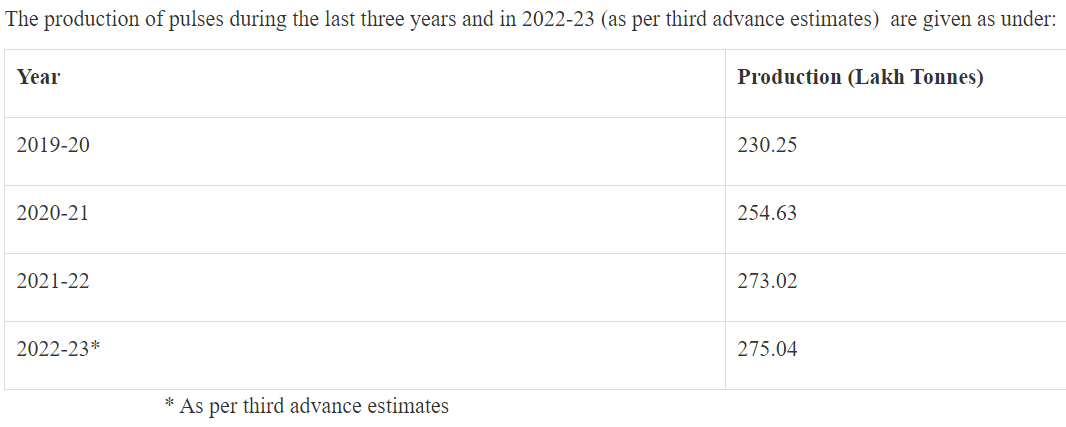Pulses Production India | 17 Aug 2023
Why in News?
Recently, the Union Minister of Agriculture and Farmers Welfare provided valuable insights in a written reply in Rajya Sabha regarding the comprehensive strategies being employed to enhance pulses production in India.
- The National Food Security Mission (NFSM)-Pulses, aimed at increasing productivity and ensuring sustainable practices in the agriculture sector was highlighted.
What are India’s Initiatives to Boost Pulses Production?
- National Food Security Mission (NFSM)-Pulses:
- About:
- The NFSM-Pulses initiative, led by the Department of Agriculture & Farmers Welfare, operates in 28 States and 2 Union Territories including Jammu & Kashmir and Ladakh.
- Key Interventions Under NFSM-Pulses:
- Assistance to farmers through States/UTs for various interventions.
- Cluster demonstrations on improved package of practices.
- Cropping system demonstrations.
- Seed production and distribution of HYVs/hybrids.
- Improved farm machinery/tools.
- Efficient water application tools.
- Plant protection measures.
- Nutrient management/soil ameliorants.
- Processing & post-harvest equipment.
- Cropping system-based trainings.
- Distribution of seed mini-kits of newer pulse varieties.
- Technological demonstrations by Krishi Vigyan Kendras (KVKs).
- Additionally, the establishment of 150 Seed Hubs for Pulses has significantly contributed to increasing the availability of quality pulse seeds.
- These hubs have collectively produced over 1 lakh quintals of quality pulse seeds since their inception in 2016-17.
- About:
- ICAR's Role in Research and Variety Development:
- The Indian Council of Agricultural Research (ICAR) plays a pivotal role in enhancing the productivity potential of pulse crops through research and development efforts. The ICAR focuses on:
- Basic and strategic research on pulses. Collaborative applied research with State Agricultural Universities.
- Development of location-specific high-yielding varieties and production packages.
- During the period from 2014 to 2023, an impressive 343 high-yielding varieties and hybrids of pulses have been officially recognized for commercial cultivation across the country.
- The Indian Council of Agricultural Research (ICAR) plays a pivotal role in enhancing the productivity potential of pulse crops through research and development efforts. The ICAR focuses on:
- Pradhan Mantri Annadata Aay SanraksHan Abhiyan (PM-AASHA) Scheme:
- This comprehensive umbrella scheme (launched in 2018) comprises three components:
- Price Support Scheme (PSS): Procurement from pre-registered farmers at Minimum Support Price (MSP).
- 2021-22: Around 30.31 lakh tonnes of pulses procured, benefiting over 13 lakh farmers.
- 2022-23 (as of July 2023): Approximately 28.33 lakh tonnes of pulses procured, benefitting over 12 lakh farmers.
- Price Deficiency Payment Scheme (PDPS): Compensates farmers for price differences.
- Private Procurement Stockist Scheme (PPSS): Encourages private sector participation in procurement.
- Price Support Scheme (PSS): Procurement from pre-registered farmers at Minimum Support Price (MSP).
- This comprehensive umbrella scheme (launched in 2018) comprises three components:
India’s Pulses Production:
- India is the largest producer (25% of global production), consumer (27% of world consumption) and importer (14%) of pulses in the world.
- Pulses account for around 20% of the area under foodgrains and contribute around 7-10% of the total foodgrains production in the country.
- Though pulses are grown in both Kharif and Rabi seasons, Rabi pulses contribute more than 60% of the total production.
- Madhya Pradesh, Maharashtra, Rajasthan, Uttar Pradesh and Karnataka are the top five pulses-producing states.
UPSC Civil Services Examination, Previous Year Question (PYQ)
Prelims
Q. With reference to pulse production in India, consider the following statements: (2020)
- Black gram can be cultivated as both kharif and rabi crop.
- Green-gram alone accounts for nearly half of pulse production.
- In the last three decades, while the production of kharif pulses has increased, the production of rabi pulses has decreased.
Which of the statements given above is/are correct?
(a) 1 only
(b) 2 and 3 only
(c) 2 only
(d) 1, 2 and 3
Ans: (a)
- In India, the important pulse crops grown in winter (rabi) are chickpea, lentil, lathyrus, field pea and kidney bean. However, green gram, black gram and cowpea are grown in both spring and rainy season.
- Black gram is a warm weather crop and comes up in areas receiving an annual rainfall ranging from 600 to 1000 mm. It is mainly cultivated in a cereal-pulse cropping system primarily to conserve soil nutrients and utilize the left over soil moisture particularly, after rice cultivation. Hence, although it can be grown in all the seasons, the majority of black gram cultivation falls in either rabi or late rabi seasons particularly in peninsular India. Hence, statement 1 is correct.
- According to the Directorate of Economics and Statistics (DES), the share of pulse production in 2018- 19 was comprised of Tur (15.34%), Gram (43.29%), Moong (green gram,10.04%), Urad (black gram, 13.93%), Lentil (6.67%), and Other Pulses (10%). Hence, statement 2 is not correct.
- A 2010 report by the Confederation of Indian Industry, states that the production of pulses grew by 45 per cent from 1951 to 2008 and in the past decade by 65 per cent between 2009-10 and 2020-21, as per the Third Advance Estimate given by the Union Ministry of Agriculture and Farmers’ Welfare.
- However, the production of Kharif pulses (tur, urad and moong), which account for about 40 per cent of India’s total pulses, has been worse than that of rabi pulses (chana and masoor).
- According to a NITI Aayog report, production of kharif pulses was rising by 8.7 per cent in 1980 but fell to -6.6 per cent by 1990. Production of rabi pulses, too, was increasing at 5.5 per cent and fell to -3.2 per cent in 1990, but it then made a recovery in the next decade and grew at 4.2 per cent after 2000.
- Thus, in the last three decades, both, the production of kharif pulses and the production of rabi pulses have increased. Hence, statement 3 is not correct. Therefore, option (a) is the correct answer.

